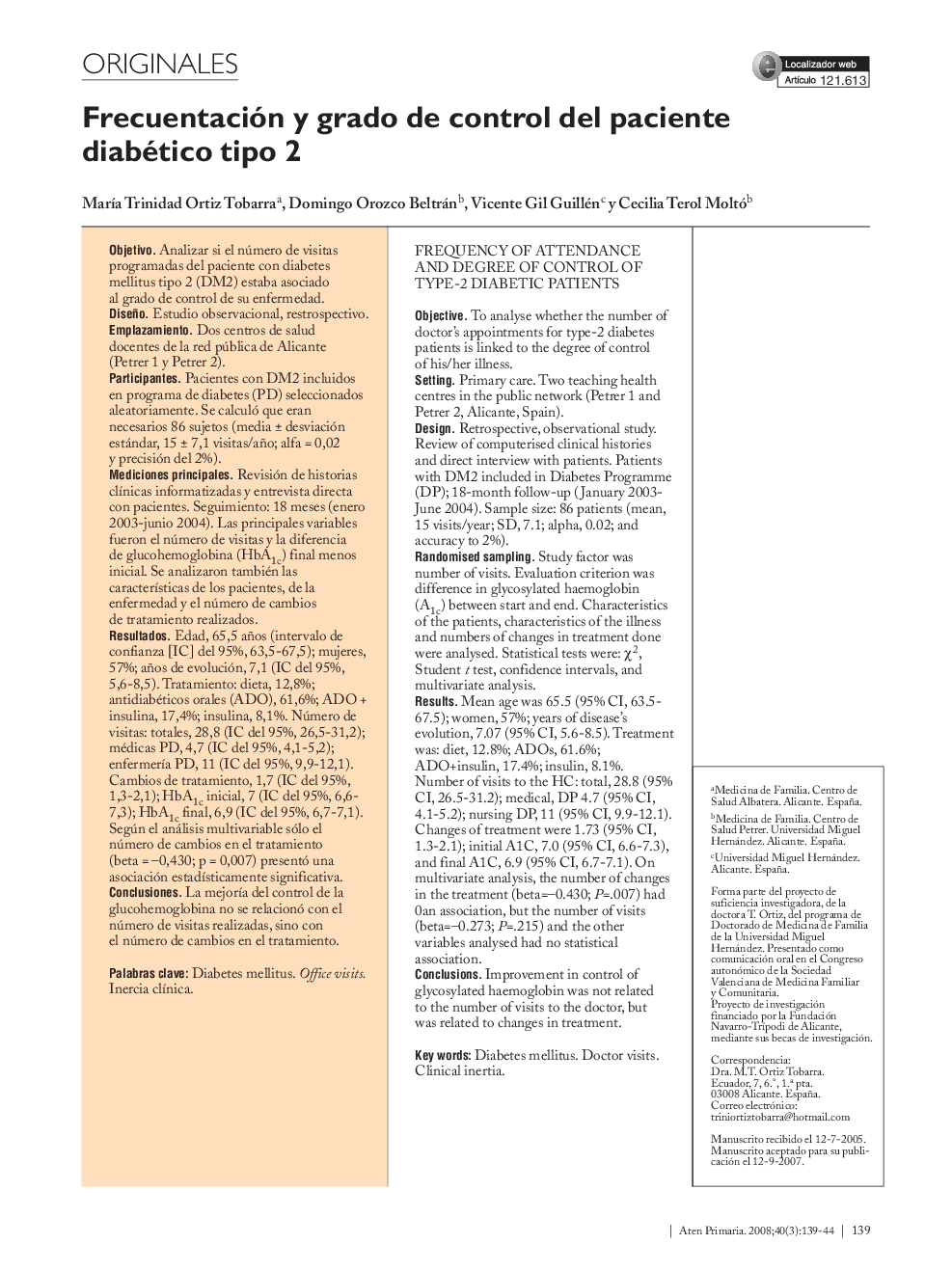| کد مقاله | کد نشریه | سال انتشار | مقاله انگلیسی | نسخه تمام متن |
|---|---|---|---|---|
| 3458616 | 1230985 | 2008 | 6 صفحه PDF | دانلود رایگان |

ObjetivoAnalizar si el número de visitas programadas del paciente con diabetes mellitus tipo 2 (DM2) estaba asociado al grado de control de su enfermedad.DiseñoEstudio observacional, restrospectivo.EmplazamientoDos centros de salud docentes de la red pública de Alicante (Petrer 1 y Petrer 2).ParticipantesPacientes con DM2 incluidos en programa de diabetes (PD) seleccionados aleatoriamente. Se calculó que eran necesarios 86 sujetos (media ± desviación estándar, 15 ± 7,1 visitas/año; alfa = 0,02 y precisión del 2%).Mediciones principalesRevisión de historias clínicas informatizadas y entrevista directa con pacientes. Seguimiento: 18 meses (enero 2003-junio 2004). Las principales variables fueron el número de visitas y la diferencia de glucohemoglobina (HbA1c) final menos inicial. Se analizaron también las características de los pacientes, de la enfermedad y el número de cambios de tratamiento realizados.ResultadosEdad, 65,5 años (intervalo de confianza [IC] del 95%, 63,5-67,5); mujeres, 57%; años de evolución, 7,1 (IC del 95%, 5,6-8,5). Tratamiento: dieta, 12,8%; antidiabéticos orales (ADO), 61,6%; ADO + insulina, 17,4%; insulina, 8,1%. Número de visitas: totales, 28,8 (IC del 95%, 26,5-31,2); médicas PD, 4,7 (IC del 95%, 4,1-5,2); enfermería PD, 11 (IC del 95%, 9,9-12,1). Cambios de tratamiento, 1,7 (IC del 95%, 1,3-2,1); HbA1c inicial, 7 (IC del 95%, 6,6-7,3); HbA1c final, 6,9 (IC del 95%, 6,7-7,1). Según el análisis multivariable sólo el número de cambios en el tratamiento (beta = −0,430; p = 0,007) presentó una asociación estadísticamente significativa.ConclusionesLa mejoría del control de la glucohemoglobina no se relacionó con el número de visitas realizadas, sino con el número de cambios en el tratamiento.
ObjectiveTo analyse whether the number of doctor’s appointments for type-2 diabetes patients is linked to the degree of control of his/her illness.SettingPrimary care. Two teaching health centres in the public network (Petrer 1 and Petrer 2, Alicante, Spain).DesignRetrospective, observational study. Review of computerised clinical histories and direct interview with patients. Patients with DM2 included in Diabetes Programme (DP); 18-month follow-up (January 2003-June 2004). Sample size: 86 patients (mean, 15 visits/year; SD, 7.1; alpha, 0.02; and accuracy to 2%).Randomised samplingStudy factor was number of visits. Evaluation criterion was difference in glycosylated haemoglobin (A1c) between start and end. Characteristics of the patients, characteristics of the illness and numbers of changes in treatment done were analysed. Statistical tests were: χ2, Student t test, confidence intervals, and multivariate analysis.ResultsMean age was 65.5 (95% CI, 63.5-67.5); women, 57%;years of disease’s evolution, 7.07 (95% CI, 5.6-8.5). Treatment was: diet, 12.8%; ADOs, 61.6%; ADO+insulin, 17.4%; insulin, 8.1%. Number of visits to the HC: total, 28.8 (95% CI, 26.5-31.2); medical, DP 4.7 (95% CI, 4.1-5.2); nursing DP, 11 (95% CI, 9.9-12.1). Changes of treatment were 1.73 (95% CI, 1.3-2.1); initial A1C, 7.0 (95% CI, 6.6-7.3), and final A1C, 6.9 (95% CI, 6.7-7.1). On multivariate analysis, the number of changes in the treatment (beta=−0.430; P=.007) had 0an association, but the number of visits (beta=−0.273; P=.215) and the other variables analysed had no statistical association.ConclusionsImprovement in control of glycosylated haemoglobin was not related to the number of visits to the doctor, but was related to changes in treatment.
Journal: Atención Primaria - Volume 40, Issue 3, March 2008, Pages 139-144